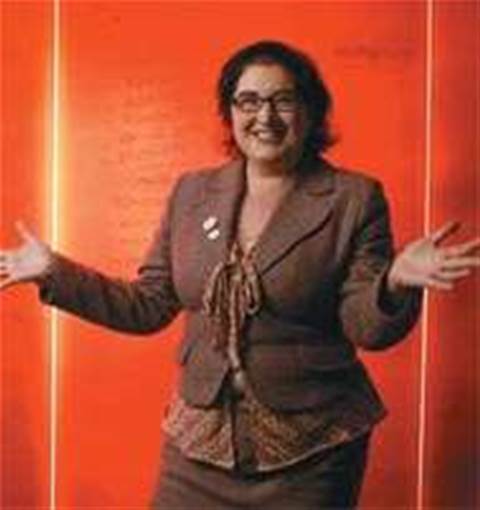“You’ve come a long way, baby.” That’s one thing you might say to WDG government business development manager Rita Arrigo after listening to her resume. That’s what they used to say last century, when the second wave of feminism confirmed the alarming proposition that women could work outside their traditional domestic sphere.
Arrigo isn’t of that generation. She’s in her late 30s. She has arguably got a longer road to travel yet. But unlike many who have achieved and learned so much, Arrigo has retained an irrepressible enthusiasm, the glee of a kid in a candy shop who has lots to experience.
Today, she works with Melbourne .NET specialist WDG. But she didn’t do much in the way of computing at school -- well, not that you could do a lot with it at school in those days anyway.
At university, she read for a degree in industrial engineering and computing.
That was the first hint of the route she might take -- a road less travelled indeed, that has taken in roles as a radio broadcaster, channel sales staffer and internet cafe operator.
“I am passionate about the benefits of technology,” she says on her blog. Doubt it not a bit. The passion oozes from every pore. Arrigo still feels a thrill from her work that must bring her success when promoting the greyer worlds of .NET and government IT. She has few, if any, regrets and reckons her current job is the best so far. “WDG is empowering. It’s a small business, where we can actually deliver real services to people,” Arrigo says. “I find that exciting.” That contrasts with Telstra, where she worked for BigPond’s channel, which she says meant being literally hamstrung by “bazillions” of acronyms and “doing everything backwards” in the way of big corporations everywhere.
Onwards and upwards
“Over the next two years is when the web gets really serious. Don’t you think so?” Arrigo says. She predicts “massive investment” in wireless and business-to-business application consolidation, all driven by web services. The ROI is really happening, she says.
Web services and applications are moving inexorably towards what Arrigo calls a “totally customer approach” to software. She says it is about communities working together to develop and deploy different tools. Instead of customising every application, users will take some technology from one place and some more from somewhere else and integrate all the elements. A bit like with service oriented architecture (SOA), web services and CRM, she says.
She is currently working on two really exciting projects. “One of them is this whole SOA process we’re establishing, which is really about helping organisations unlock their legacy data and being able to make use of it. And the other aspect is developing a range of hosting solutions where people can cost-effectively deploy their applications. But the other one is confidential at the moment,” she says.
These trends are not only making it easier to deploy applications, but providing a vision for the future, especially for organisations like WDG that have come from the web but are now moving into delivering critical applications and robust platforms, Arrigo says.
“I find the developers out the back awesome. They’re very innovative,” she says.
“It’s not about how can we rip this customer off but how can we be creative and give people what they want. And I find that is often not a priority in an application development environment.” If there’s one thing that has been a constant theme on Arrigo’s road, it is looking for new ways to help people. It also has to be fun.
“When I worked at Telstra, it was a really exciting time to be at Telstra. It was the time of the boom of the whole internet thing,” she says.
Arrigo says there was heavy investment around lots of potential IP services. "The driver for me is always about being on the edge. And being around stuff that is still in the early adopter stage and taking it to maturity. Then I want to do something new and exciting," she says.
If you’re not living on the edge, they say, you’re taking up too much space. Which, she concedes, could well be why she moved from industrial engineering in the first place.
“I had done work experience at Kodak and had a little stopwatch and I had to watch these people fill those bottles of process chemicals and photography reagents,” she says.
Arrigo implies she found some of the daily grind of industrial engineering -- focusing on business processes in detail to develop more efficient practices -- somewhat boring. Yet the things she learnt have been of inestimable value. The tenets of business process design are useful across multiple industries, not just in manufacturing.
“I think that has helped me, when you run around saying you want to make a difference in such-and-such an area,” Arrigo says.
If you are not disciplined, that does make it harder to become accomplished at any serious endeavour.
Arrigo sees her industrial engineering training as having helped her develop the ability to back up creativity, ideas and individuality with rigour, “with process and discipline and old-fashioned tools”.
Variety is the spice
By
Fleur Doidge
on Oct 13, 2005 4:25PM

Rita Arrigo
Page 1 of 2 | Single page
Got a news tip for our journalists? Share it with us anonymously here.
Partner Content

Shure Microsoft Certified Audio for Teams Rooms

Channel faces AI-fuelled risk as partners lag on data resilience, Dicker Data summit told

Promoted Content
From Insight to Opportunity: How SMB Service Demand is Shaping the Next Growth Wave for Partners

Tech Data: Driving partner success in a digital-first economy
_(11).jpg&h=142&w=230&c=1&s=1)
The Compliance Dilemma for Technology Partners: Risk, Revenue, and Reputation






.jpg&w=100&c=1&s=0)
_(8).jpg&w=100&c=1&s=0)









